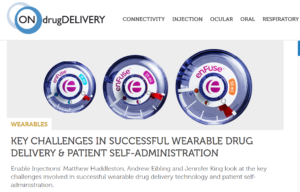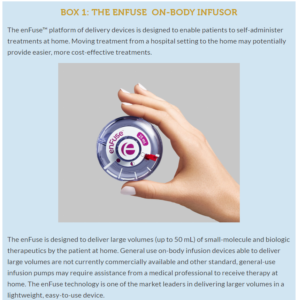Key Challenges in Successful Wearable Drug Delivery and Patient Self-Administration
The September 2019 issue of OnDrugDelivery features a new article, Key Challenges in Successful Wearable Drug Delivery and Patient Self-Administration. In the article, Enable Injections’ Matthew Huddleston, Andrew Eibling and Jennifer King look at the key challenges involved in successful wearable drug delivery technology and patient self-administration.
Read an excerpt with a link to the published article, below:
Key Challenges in Successful Wearable Drug Delivery and Patient Self-Administration 
Cutting-edge biologic therapies often require patients to receive treatment through frequent IV infusions at a hospital or infusion clinic. But what would happen if those same biologics could be given by the patient through a simple through-the-skin infusion at home? Why has there not been a greater push for wearable technology that allows people to self-administer infused medicines at home?
Armed with game-changing technology which makes this a possibility, Enable Injections’ goal is to reduce the treatment burden on people living with a wide-range of conditions and put control back into the hands of the patient.
The world is ready for the possibility. US Healthcare costs are increasing at a rate of 3-4% per year1. Evidence shows a reduction in the overall cost when therapy is administered in the home compared to a doctor’s office or clinic2. Patients are ready for it, too. Evidence shows improved compliance and adherence to medications when patients can complete the therapy at home compared to administering infusion in the physician’s office or clinic3. 
Up to this point, technology has been the limiting factor. Biologic therapies often start with intravenous (IV) infusion and require large volumes for efficacy. Transition to subcutaneous delivery may even require higher volumes due to bioavailability. These large volumes are not suitable for administration via auto-injectors and prefilled syringes. Large infusion pumps are available for subcutaneous delivery in the home, but they are complex, and often require in-home infusion services for administration.
There exists the need for a cost-effective, simple-to-use, large volume, subcutaneous, self-administration infusion system which creates real value for both the pharmaceutical companies and the patients. With the right technology, the market environment is primed to transition.
Click here to read more about Pharma and Patient Challenges in the published article at the OnDrugDelivery website.
The Human Element in Drug Delivery Device Design
In designing a drug delivery device, one of the most important considerations is the patient’s interaction with the device. However, the human element in engineering of a drug delivery device is a complex factor. The design features incorporated into the delivery device should reflect the needs of all users. Through human factors studies, Enable can learn more about the way humans interact with the user interface features of the device. Device design, when influenced by human factors data earlier in development, may achieve a more intuitive design for end users.
Through human factors studies, Enable can learn more about the way humans interact with the user interface features of the device. Device design, when influenced by human factors data earlier in development, may achieve a more intuitive design for end users.
User Factors
Unmet User Needs
Necessity is the mother of invention. When Enable Injections founder Mike Hooven and team began to investigate unmet needs associated with injections, they discovered a high user burden associated with receiving an IV infusion. Intravenous (IV) drug products require a trip to a healthcare facility for administration. IV administration also involves an infusion administrator, facility costs, and lengthy administration times. Users and patients currently spend hours receiving IV infusions at healthcare facilities worldwide because of the lack of portability of the infusion experience. As pharmaceutical companies develop subcutaneous (SC) formulations for their medicinal products, Enable is working on a convenient drug delivery system to partner with drug products to provide the most user-friendly infusion to patients. Current options for patient self-administration of SC formulation volumes larger than 5 milliliters (mL) may involve cumbersome setups and complex needles, tubing, and pumps. Other options include autoinjectors and pre-filled syringes for volumes less than 5 mL. The Enable enFuse® design strategy focused on the development of a portable infusion pump for large-volume SC formulations to improve the patient experience.
User Convenience
Pharmaceutical companies, physicians, and health insurers prefer for patients to feel at ease with receiving their prescribed therapeutic and that they are in control of their condition. When patients can be relaxed and in control, they are more likely to adhere to their prescribed treatment. Therefore, it is of primary importance that the patient feels in control and that the treatment regimen is simple and convenient. Human factors studies inform device designers how the user interacts with a device. Device users may include patients, but also their caregivers and healthcare professionals (HCP). All relevant users of a device should be considered when planning human factors studies. Questions that may be relevant for preparation of human factors studies for a drug delivery device include:
- How does a patient with a specific disease interact with a device delivering a therapeutic?
- What is the care burden on the patient? Are they able to self-administer, or do they need help from a caregiver or HCP?
- Does the patient understand the Instructions for Use (IFU), or does the IFU need to be modified for clarity?
- Can the patient execute all of the steps in the IFU? Is there too much physical or cognitive load?
User Interface Features
Device engineering best practice focuses on design of the user interface, including factors such as handedness, orientation, operational visibility, intended touchpoints, and device feedback. Each of these features needs to be designed with the end user in mind.
Human Factors Studies
Controlled studies, such as focus groups, ethnography, contextual inquiry, and heuristic evaluations, are run in individual or group settings to help identify usability problems associated with the user interface design, thereby making them addressable and solvable earlier in development. In the case of the Enable enFuse®, a platform of wearable devices enabling patients to receive high-volume therapeutics outside of a healthcare facility, a wide variety of different user groups have been considered in human factors studies to inform the device design. The needs of users across a broad age range (including pediatrics, adolescents, and adults) and their interactions with the enFuse should be considered. In addition, each disease state may have different conditions and/or impairments, including muscle coordination and strength, that may impact the device user interface design. All of these considerations influence human factors study design and the output data is critical to inform the device design.
Impact on the Design
The enFuse design of the user interface elements has been largely influenced by human factors studies. For example, a user interacting with the enFuse device will be able to remove the device from the transfer system and have visibility with the fill gauge, independent of their handedness. Other design features influenced by human factors studies include:
- Flat grip space is integrated into the device, especially for the larger volume devices, for handling and gripping the enFuse.
- Openings in the transfer system fluid path give the user visibility as to the transfer status.
- Characterization of the device adhesive elements with respect to adhesion and comfort.
Comprehensive and controlled human factors studies are completed during development to inform the device design. A well-designed device enables the user to have a positive interaction experience and feel more in control of their disease; these factors may support patient compliance with their prescribed treatment and ultimately improve their quality of life. Author: Eileen Rogers, Vice President of Program Management and Human Factors, Enable Injections Resources:
- National Home Infusion Association, https://www.nhia.org/index.cfm.
- RMS Medical Products, FREEDOM60, https://www.rmsmedicalproducts.com/products/home-infusion/freedom60/.
- Hill, Robert L. “Comparison of drug delivery with autoinjector versus manual prefilled syringe and between three different autoinjector devices administered in pig thigh.” Med Devices, 2016; 9: 257-266. https://www.ncbi.nlm.nih.gov/pmc/articles/PMC4976900/ Accessed 26MAR2019.
- Wells, Nancy, et al. “Improving the Quality of Care Through Pain Assessment and Management.” Patient Safety and Quality, Agency for Healthcare Research and Quality, 2008. https://www.ncbi.nlm.nih.gov/books/NBK2658/Accessed 26MAR2019.